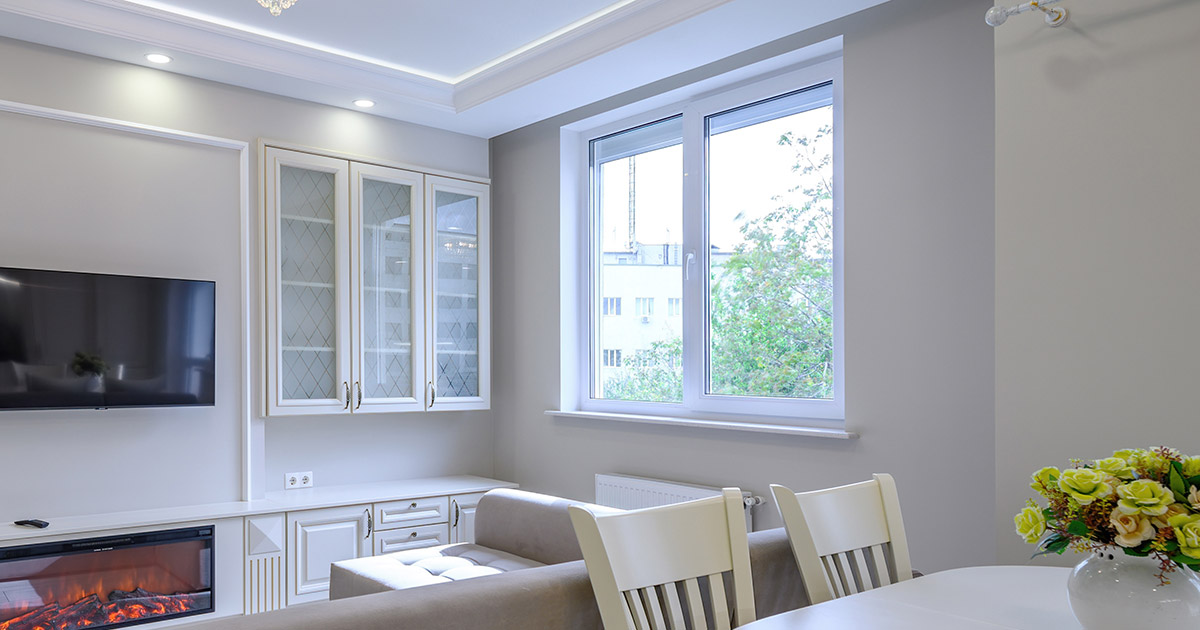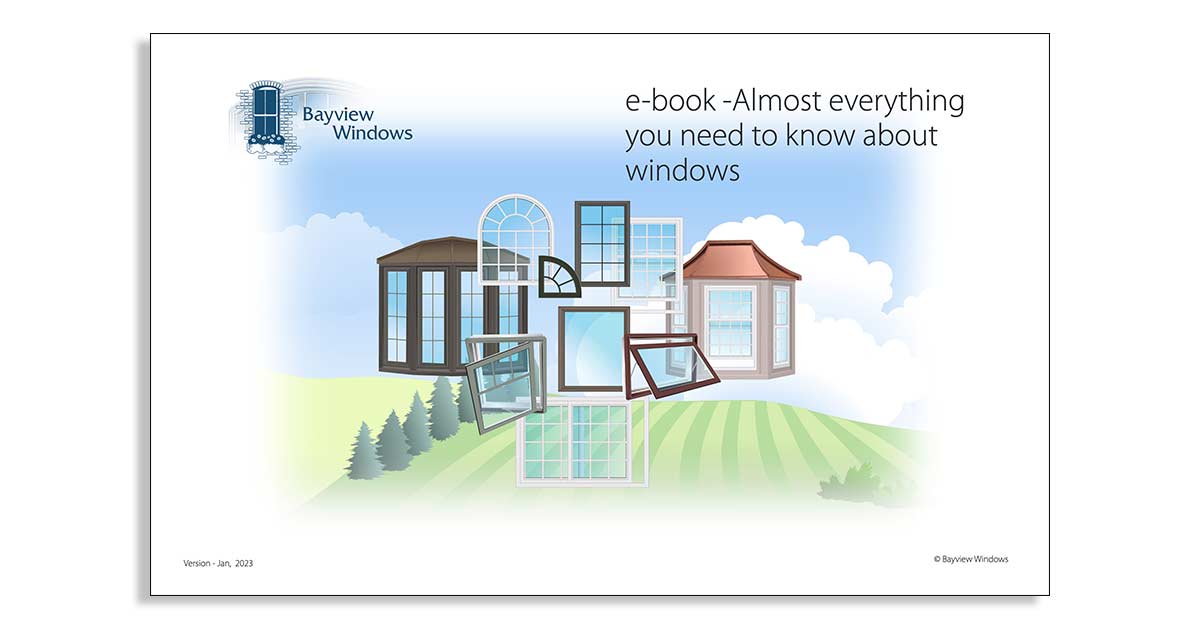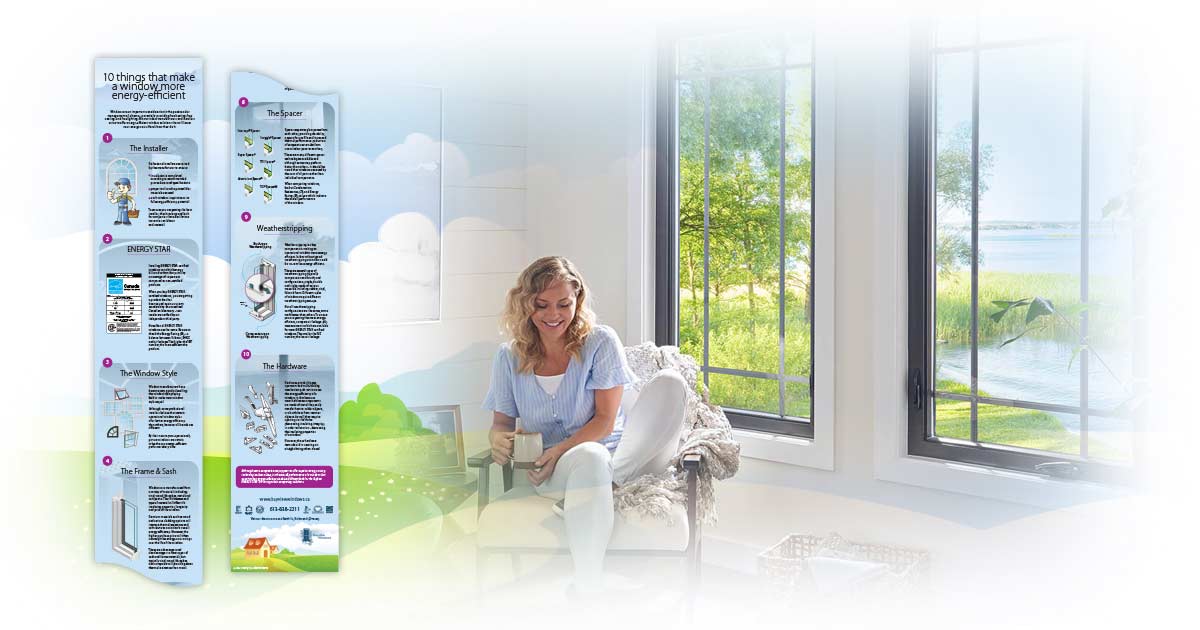Insights > Category > Posted: 2023-Nov-16, Updated: 2025-Jan-15
Window Options
Reducing Outside Noise

If you find yourself in the market for new windows, selecting the right combination of features may offer a solution to keep unwanted external noise at bay. However, this choice involves a delicate balance between energy efficiency, aesthetics, functionality, and cost.
Before you begin your search for the perfect sound-eliminating window, we’ve compiled a list of terms, comparative examples and solutions to help you achieve the results you looking for.
Quick reference - items covered in this post:
- Factors that affect the amount of sound that passes into your home
- Glass principles that reduce sound transmission into the home
- Understanding acoustic rating systems
- Standard window configuration vs window optimized for noise reduction vs soundproof windows
- The mechanics of sound (definitions)
- Energy-efficiency and sound-damping solutions
- Customized replacement window sound reduction solutions
- Best window type for optimal sound control (summary)
Uncovering the sources of noise
Before delving into acoustic-optimized windows, it's crucial to rule out other household conditions contributing to sound leakage. Cold air return and dryer vents, poor insulation, faulty caulking, and chimneys can all be contributing factors.
Note: If your home still has single-pane windows, replacing them with dual-pane windows can increase the STC rating from 15-20 to 25-30 (see window ratings below).
Factors that affect the amount of sound that passes into your home
Several factors influence the amount of sound that permeates your home, including the size of the window opening, location, type of noise exposure, home design and materials, and the placement of fresh air vents.
Glass principles that reduce sound transmission into the home
In general, to increase a window’s ability to block sound and increase its STC rating, the window manufacturer can:
- Make the glass thicker (adding mass)
- Add more panes (with a suitable space between them)
- Use laminated glass (glass-plastic-glass sandwich)
- Make sure the windows are installed properly and professionally, tight to the frame with no blocking
Understanding acoustic rating systems
There are two main rating systems used in the construction industry to communicate how well a product will block out sound: Sound Transmission Class (STC) and Outdoor/Indoor Transmission Class (OITC). Both are typically used to measure the reduction of sound for a window. STC ratings, although older than OITC is the preferred rating method used in the window industry.
Typically, neither STC nor OITC ratings are provided in window quotes, but some window manufacturers understand the needs and wants of their customers and do have specifications on sound reduction upon request. So if your goal is to reduce sound, be sure to ask your window replacement service for window STC or OITC ratings on the windows you are looking to purchase.
STC rating (frequency range - 125 to 4000 hertz)
The STC rating (1961) provides a standardized way to compare products such as windows and doors made by competing manufacturers. This rating gives an indication of the noise reduction of high-frequency sounds such as voices and birds… It is a single-number method of rating that states how well various partitions reduce sound transmission. The larger the number, the better the window is at reducing the sound that enters the home.
It should be noted, that a 2-point STC improvement for a window is not perceptible and a 10-point improvement might filter sound out as much as 50%. An STC rating of 50 (which is not a typical rating for any window) would block as much as 95% of external noise.
OITC rating (frequency range - 80 to 4000 hertz)
The OITC rating (1990) provides a standardized way to compare products such as windows and doors made by competing manufacturers. This rating is used to measure sound transmission loss of lower frequency sounds that are produced by automotive traffic, construction, lawnmowers, low-flying aeroplanes… It is also a single-number method of rating that states how well various partitions reduce sound transmission. The larger the number, the better the window is at reducing low-frequency sounds that enter a home.
OITC is a more accurate and preferable rating when addressing sound insulation from exterior noise, however, the majority of window manufacturers use the STC rating. When comparing ratings, a difference of 1 point is inaudible.
Some STC window rating comparisons
Standard window configuration vs window optimized for noise reduction vs soundproof windows
A standard dual-pane window will typically have an STC rating between 25 and 27, however, the rating can be potentially increased by 5-7 points by selecting appropriate noise-reducing options.
Soundproof windows are a totally different ballgame - components, framing, and glass are all optimized with one goal in mind - soundproofing. Soundproof windows are up to three times more expensive than a typical replacement window. A true soundproof window may have an STC rating that approaches 50.
The mechanics of sound (definitions)
Sound is measured in decibels, sound frequencies are measured in hertz. While low-frequency sound low-flying aircraft, street traffic, construction and large mechanical equipment - high-frequency noise includes birds, sirens, children playing in a park and whistles. Keep in mind, sound and ratings are somewhat subjective - what is acceptable for one person may be very bothersome to another.
When sound comes in contact with a barrier, such as a door or a window, some of the energy from the vibrations transfers to the door or window. The resulting vibrations in the door/window itself then set the air in motion on the other side of the door/window, creating more sound vibrations.
The mass, damping and stiffness of the barrier determine its resistance to the passage of sound waves. The greater the mass, the less sound is transmitted through the barrier. The stiffer the barrier the higher the sound transmission. Damping is anything that can slow down or reflect a sound going through a barrier.
Frequency (Hertz or Hz)
Sound is produced when a sound wave moves air molecules as it passes through it - our brains translate these waves into sound through a complicated series of inner workings within our ears.
Frequencies express the number of sound waves that pass by a given point per second (measured by how many times the wave completes a cycle in a second) Hertz (Hz).
Humans can hear frequencies ranging from 20 Hz to 20,000 Hz (20k Hz). Dogs can hear sounds as high as 65,000 Hz (65k Hz). The higher the frequency (Hz), the higher the pitch.
Decibels (dB)
The unit that measures the amplitude pressure (loudness) of sound. This Sound Pressure Scale begins at 0 decibels (the threshold for audibility for humans). The higher the decibels, the louder the sound.
Acoustic medium
An acoustic medium is any material through which sound can travel. It can be air, water or solid, it can be a wall, a window a door, or anything. If you are talking about sound travelling through glass, then the glass is the acoustic medium.
In order for sound to travel, it must have something to travel through - an acoustic medium. Thus, because there is no medium in a vacuum, sound cannot travel through it.
Sound transmission
Sound transmission is the travelling of sound waves through air, water and solid masses. Soundwaves can be measured in decibels (volume or loudness) and frequency (pitch) which is measured in hertz.
A material’s stiffness
A material’s stiffness is its elasticity, and whether it increases or decreases the speed of sound and sound transmission. The stiffer the material, the faster it travels through it. Sound travels fastest through solids, slower through liquids and slowest through gases.
Steel is a very stiff material - as a result, as you’ve probably seen in old Westerns, you can hear a train coming from miles away if you put your ear to a train rail.
Foam is a less stiff porous material - it absorbs the vibration of the air contained in its pores and sound energy is lost by friction against their edges
Material density (mass)
The density of a medium is another factor that affects the speed of sound. Density describes the mass of a substance per volume. A substance that is denser per volume has more mass per volume. Usually, larger molecules have more mass. If material is denser because its molecules are larger, it will transmit sound slower. The elastic (material stiffness) properties usually have a larger effect on sound travel than the density.
Sound damping
Sound damping is a term for any pre or post-installation method that will reduce the transference of sound from one area to another. Window manufacturers use a variety of methods to help your windows filter out unwanted sound.
Sound absorption
Sound absorption is the measure of the amount of energy removed from a sound wave as it passes through a given material. For example: As sound passes through a window, some of the sound is absorbed by the materials that the window is made up of, thus making the sound less intense on the interior of the home. If measured, sound absorption is the amount of sound that does not make it through the window. Sound absorption is typically measured in % of loss when talking about sound absorption in windows.
Soundproofing
Soundproofing refers specifically to the action of blocking sound from an area - any means of reducing the sound pressure with respect to a sound source. There are several basic approaches to reducing the sound that includes increasing the distance between source and receiver, using noise barriers to reflect or absorb the energy of the sound waves, using damping structures such as sound baffles, or using active antinoise sound generators.
In order to produce a true soundproof window all components from the frame to the glass must be optimized for the reduction of sound through them.
Sound leakage
A sound leak is any area of a home where external noise is finding its way inside the home. Sound leakage can come from broken window and door seals, single-pane, air ducts and returns, cracks in electrical outlets and walls and poorly insulated attics.
Energy-efficiency and sound-damping solutions
Solutions that reduce sound transmission through a window change its energy-saving properties since the window is optimized for sound reduction, not energy efficiency. When you are shopping for new windows - if energy efficiency is important to you, be sure to tell your window consultant that you are looking for an energy-efficient and sound-reducing solution.
Customized replacement window sound reductions solutions
There are lots of different ways, that window companies can reduce sound transmission through a window without providing a true soundproof window (optimized in every way for sound reduction) and associated costs.
These solutions include:
Laminated glass
Laminated glass is produced by permanently bonding two pieces of glass together with a tough plastic interlayer between them, keeping the layers of glass bonded even when broken. North Star Windows offers an insulated glass unit that is made up of a 6mm laminated glass (3mm/3mm) to the exterior and a standard 3mm glass to the room side to effectively changes the frequency of the sound waves as they pass through the insulated glass unit, reducing decibel levels. Laminated glass also acts as an additional security barrier, as it stays intact even if shattered.
Triple-pane glass
Triple-pane windows can increase the STC rating number when compared to a dual-pane window by as much as 7 points as long as the three panes are in an optimal position from each other - In some cases, they add a bit more mass and in others they offer more dead space between the panes to block sound.
Dissimilar glass panes
All window manufacturers do things differently, but a typical scenario for this solution might be a dual-pane window in which the two panes of glass are of different thicknesses. One pane might be one-eighth of an inch thick and the other a quarter of an inch thick. These dissimilar glass panes block different sound frequencies, giving you more noise protection.
Frame and sash material
The material and thickness of both the frame and sash do have an effect on STC ratings. Wood or vinyl frame and sash materials perform much better than aluminium conducts sound. Some manufacturers fill both the sash and frame of the window with foam which in practice seems like a good way to reduce sound from entering the home. However, some window manufacturers claim that chambers help to reduce sounds from entering the home. Having trouble deciding - check the STC ratings for both window processes.
Type of window
Selecting the right type of window (less infiltration means less sound leakage into the home). Typically, depending on window/glass configuration sound reduction by type starts with the picture window followed casement, hung, sliding and awning which are typically equal. To be sure, check the STC rating for each of these windows individually.
Specialized soundproofing windows
Soundproof windows are different from sound-reducing windows. They are manufactured specifically to eliminate as much sound from passing through them as possible. These windows can be very expensive, as they are a specialized product in which all components are designed with soundproofing in mind. True soundproof windows are not typically available from most window replacement companies.
Note: if the external walls in your home have an average STC rating of 30-35 and you are considering soundproof windows with an STC rating of 50, then you would be wasting your money, because although sound would not be passing through your new windows, it would still be passing through your walls.
Aftermarket soundproofing solutions
If you are not yet in the market for replacement windows, there are some quick-fix solutions that may offer some relief from external sound.
Laminating glass
Aftermarket film laminates can filter out as much as 5 decibels of sound according to some manufacturers. Typically made with 3 layers, the centre one does all of the sound blocking. The two layers on either side of it are made from polymer and support the product’s application and aesthetics. These films can be installed on virtually any type of window or glass.
Curtains & blinds
While window coverings alone can’t make your home soundproof, they can absorb noise coming through the window and help reduce exterior noise. Look for a honeycomb design, they can insulate your windows from the heat and cold as well. There are plenty of companies and solutions out there to meet your acoustic and aesthetic needs.
Window inserts
Inserts can be installed behind an existing window adding dead, sound-reducing air between the principal window and the new interior insert which can have an STC rating of 38 up to a 95% noise reduction depending on the size of the window opening and type of noise.
These windows create large airspaces between the set of 2 windows which kills noise by disrupting the sound waves. Note: these windows are typically made as non-operational windows and will prevent access to functional windows.
Best window type for optimal sound control
In conclusion, today’s window technology offers some practical and relatively inexpensive solutions to sound control that can be easily achieved with the right combination of options.
However, in order to find a balance between energy efficiency, sound insulation, bulkiness, functionality and aesthetic attributes, you need to work with your replacement window consultant. Let them know what you are willing, or not willing to have in a window, and they’ll help you find the right solution for you.
Also, make sure that the STC rating of your new windows matches the rating of your home’s walls and roof, otherwise, you may be wasting money on overengineered windows, as sound will still pass through other areas of your home.
You should verify a window’s sound rating by reviewing an acoustical test report performed by a certified lab. Don’t take the salesperson’s word for it, if there’s anything that doesn’t quite make sense in the shopping/quoting process, don’t let it go - ask lots of questions.
Related stories
Need more information?
If you would like more information about reducing the amount of sound coming through your new replacement windows. We’d be happy to address all of your questions or concerns.
20 Best Value Tips
Free E-Book
E-BOOK GUIDE
INFOGRAPHIC
INFOGRAPHIC
Fogged Window Panes
Signs & Considerations
Builders vs Premium Grade
Full-Frame vs Pocket
You've Got Options
Basement Windows
The Art of Window Shopping
Top Considerations
Custom Window Shapes
Window Types
INFOGRAPHIC
Right For Your Home
Single-Glaze vs Multi-Glaze
INFOGRAPHIC
Window Interior
Window Exterior
Best Replacement Windows
Choosing a Material
Reducing Outside Noise
Window Grills
Operational Windows
The Colour Process
Weatherstripping
Window Jambs
Window Flashing
Window Spacers
Trim, Capping, Cladding...
Self-Cleaning Windows
Sash vs No Sash Windows
Bay and Bow Windows
Slider Configurations
Slider Pros & Cons
Awning Pros & Cons
Casement Pros & Cons
Hung Pros & Cons
Window Energy Efficiency
The basics
30 Common Myths
Do's and Don'ts
Winter Screen Protection






